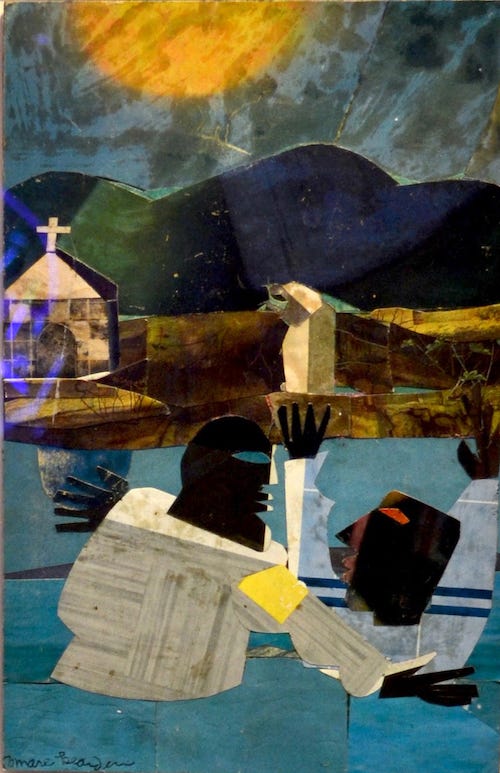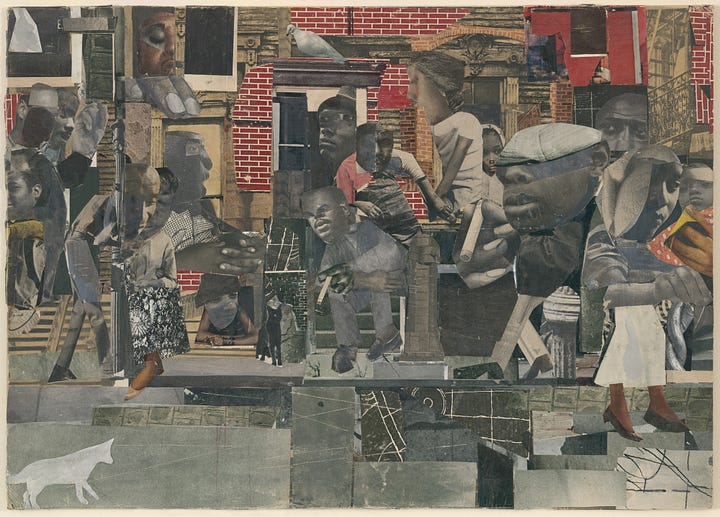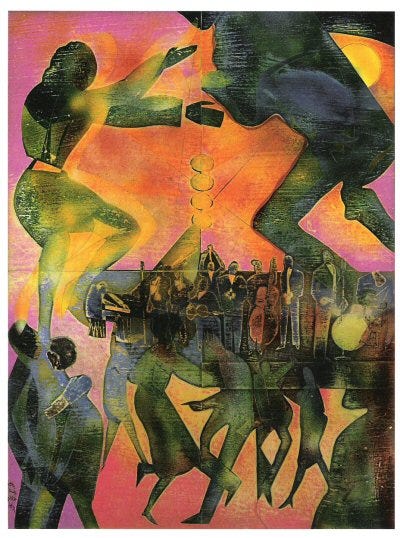Romare Bearden (1911–1988) is widely recognized as one of the most influential American artists of the 20th century. Best known for his groundbreaking collages that explore the multifaceted experiences of Black life and culture, Bearden transformed everyday imagery into a complex visual language that speaks to history, identity, and community. Drawing inspiration from the Harlem Renaissance, jazz, African art, and European modernism, his work redefined modern art by merging abstraction with figurative storytelling.
Born on September 2, 1911, in Charlotte, North Carolina, Romare Bearden moved with his family to Harlem during the Great Migration; a move that would immerse him in the cultural and intellectual ferment of one of America’s most vibrant Black communities (Fine 22). Growing up in Harlem during the Harlem Renaissance, he was exposed to music, literature, and visual arts that celebrated Black excellence and resilience. His parents, who were connected with influential Black intellectuals such as W.E.B. Du Bois and Langston Hughes, nurtured a creative environment that would shape his artistic vision (Patton 14).
Bearden pursued higher education at New York University, earning a degree in education in 1935. However, his true calling lay in art. He enrolled in courses at the Art Students League, studying under the German émigré painter George Grosz. Grosz’s focus on social realism and narrative imagery profoundly influenced Bearden’s later work, as did the exposure to Cubism and Dada movements in Europe (Schwartzman 45; Weaver 67). These diverse influences laid the groundwork for Bearden’s distinctive visual style, which blended traditional Black cultural motifs with modernist techniques.
In the 1960s, Bearden’s creative practice shifted decisively toward collage, a medium that would become his signature. Collage allowed him to combine disparate images, textures, and materials (such as cut and torn photographs, painted paper, and fabric) into complex compositions that captured the fragmented yet resilient nature of Black life. This method mirrored the improvisational spirit of jazz and the oral traditions of African storytelling, effectively challenging conventional narrative forms (Powell 98).


Works from his acclaimed Prevalence of Ritual series (1964–1974), including pieces like Baptism and The Dove , merge personal memory with collective experience. These pieces serve as visual essays on community, migration, and spirituality, capturing the dynamism and struggle inherent in African American history (Campbell 32). By layering multiple images to create a single, multifaceted narrative, Bearden not only redefined collage as an art form but also established a new visual vocabulary for expressing the African American experience.
Bearden’s art is saturated with themes that speak directly to the African American experience. His work vividly portrays the day-to-day realities, struggles, and triumphs of Black Americans. His series often explores the dichotomy between rural life in the South and urban experiences in the North, reflecting the broader narrative of the Great Migration (Campbell 59; Jones 112).
Having experienced the Great Migration firsthand, Bearden’s collages frequently address the themes of movement, exile, and the search for identity. His visual narratives encapsulate the tension between the promise of new beginnings and the pain of leaving one’s roots behind (Jones 116).
Deeply influenced by the rhythms and improvisational nature of jazz, Bearden’s work resonates with musicality. His compositions mimic the spontaneity and syncopation of jazz music, and he maintained close personal relationships with jazz legends like Duke Ellington and Thelonious Monk (Powell 121; National Museum of African American History and Culture).

Bearden integrated motifs from African masks, Caribbean iconography, and Black folklore to create works that celebrate a pan-African identity. Pieces such as Of the Blues: At the Savoy (1974) highlight the continuity of cultural expression across the African diaspora (Fine 87).
Beyond the visual spectacle, Bearden’s work is an exploration of collective memory and cultural identity. His collages often serve as repositories for the shared experiences of Black Americans, challenging both personal and collective histories.
Emerging during a period marked by the Civil Rights Movement and a broader struggle for racial equality, Bearden’s art provided a counter-narrative to the exclusion of Black voices from mainstream culture. Although not overtly political in the manner of protest art, his work embodied a quiet resistance through its affirmation of Black identity and heritage. In 1963, Bearden co-founded the Spiral Group; a collective of African American artists dedicated to exploring political and social issues through art (Schwartzman 102; National Gallery of Art).
The Spiral Group sought to redefine African American art by integrating abstraction with figurative representation, thereby challenging prevailing stereotypes and reclaiming Black narratives. Bearden’s collages, which incorporate images of everyday life, historical events, and mythological references, are a testament to the resilience of Black culture and the transformative power of art in times of social upheaval.
Romare Bearden’s influence on contemporary art is both profound and enduring. His innovative use of collage paved the way for later generations of artists, such as Kerry James Marshall, Mickalene Thomas, and Kara Walker, who continue to explore themes of identity, history, and representation (Patton 134). Major institutions, including the Smithsonian American Art Museum, The Metropolitan Museum of Art, and the National Museum of African American History and Culture, have featured retrospectives of his work, ensuring that his contributions remain central to American art history (Fine 143; “Romare Bearden,” MoMA).
Beyond the visual arts, Bearden’s interdisciplinary approach, merging literature, music, and theater, has influenced cultural studies and Black intellectual thought. His illustrations for publications and collaborations with writers like Toni Morrison have further solidified his reputation as a storyteller whose art transcends medium. Bearden’s work continues to be celebrated for its capacity to capture the complexities of the Black experience, serving both as historical documentation and as a source of inspiration for social change.
Romare Bearden’s artistic legacy is defined by his ability to transform the fragmented images of everyday life into powerful, cohesive narratives of Black identity and resilience. His innovative collages not only broke new ground in modern art but also provided a vital visual record of African American culture and history. By drawing upon a diverse array of influences, from African traditions to European modernism and jazz, Bearden created a distinctive visual language that continues to inform and inspire. As scholars and curators revisit his body of work, Bearden’s contributions remind us that art can serve as both a mirror to the past and a beacon for future generations striving for social justice.
References:
Campbell, Mary Schmidt. An American Odyssey: The Life and Work of Romare Bearden. Oxford University Press, 2018.
Fine, Ruth. Romare Bearden: A Black Odyssey. National Gallery of Art, 2012.
Jones, Kellie. Eyes Off the Prize: The Great Migration and the Making of Modern America. Cambridge University Press, 2013.
National Museum of African American History and Culture. Romare Bearden. NMAAHC, https://nmaahc.si.edu/explore/stories/collection/romare-bearden. Accessed 6 Jan. 2025.
Patton, Sharon F. African-American Art. Oxford University Press, 1998.
Powell, Richard J. Black Art: A Cultural History. Thames & Hudson, 2002.
Schwartzman, Myron. Romare Bearden: His Life and Art. Harry N. Abrams, 1990.
Smithsonian American Art Museum. Romare Bearden. Smithsonian American Art Museum, https://americanart.si.edu/artist/romare-bearden-3612. Accessed 6 Jan. 2025.
Weaver, Susan. Romare Bearden and the Art of the Civil Rights Movement. University Press of Mississippi, 2006.




Fascinating ‘lineage’ starting to build here in his connection to Ellington and Monk, then becoming an influence for Walker; brings to mind Basquiat’s deep obsession with Charlie Parker also aligned to The Savoy, while also immersing himself in the work of Dizzy Gillespie, Miles Davis, Max Roach, and Lester Young while actually being an influence on Warhol. I’m not sure yet where I’m going to net with this yet but I see a bigger essay coming out of this. Just keep feeding the machine brain of mine. It will flesh out.
I hadn’t heard of Romare until I took a collage class yesterday and the instructor named him as an inspiration, then I saw Romare piece at the Whitney Museum later in the day. Now I just read your intro to his life. Wild how the universe places learning in your path.